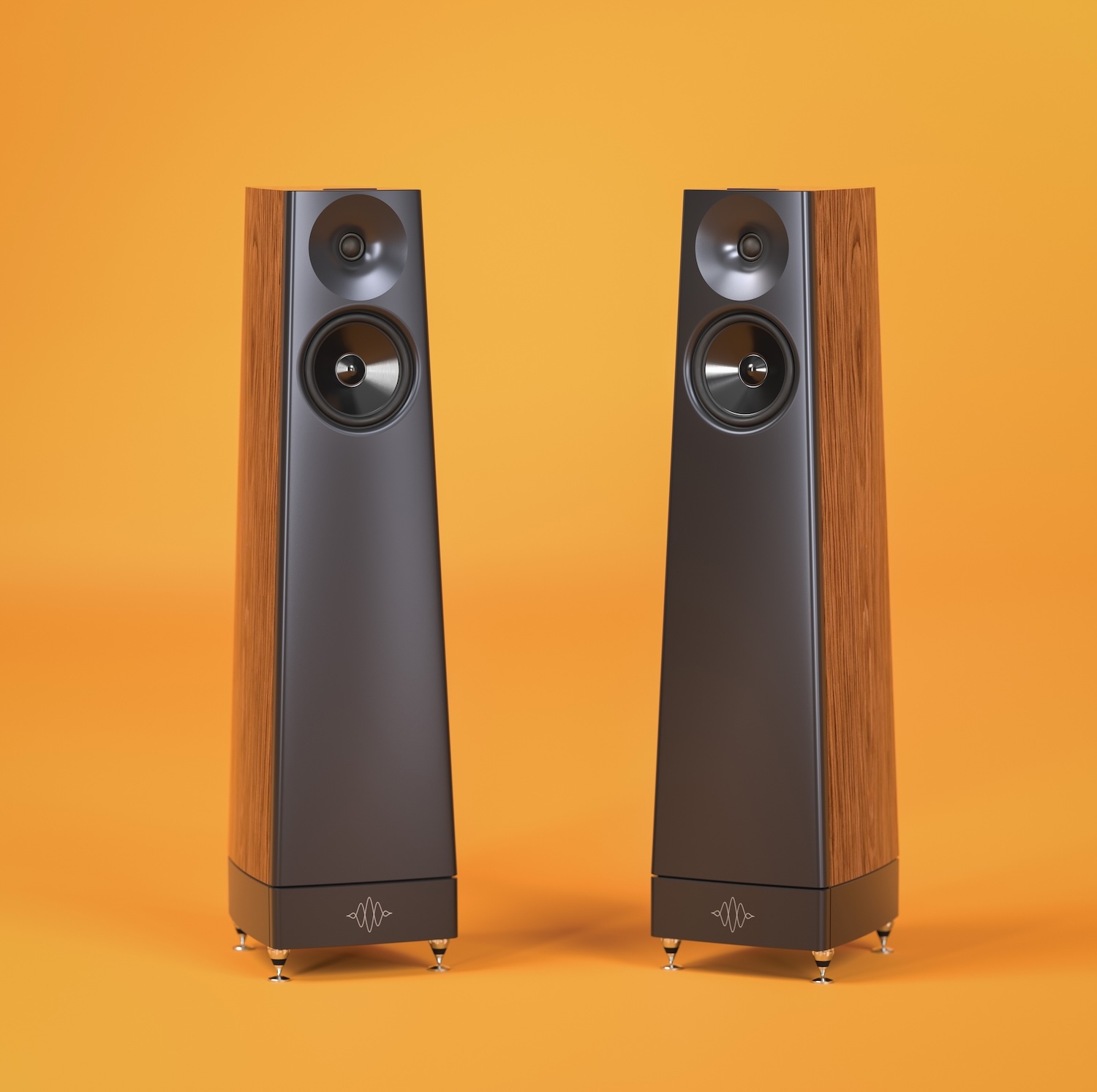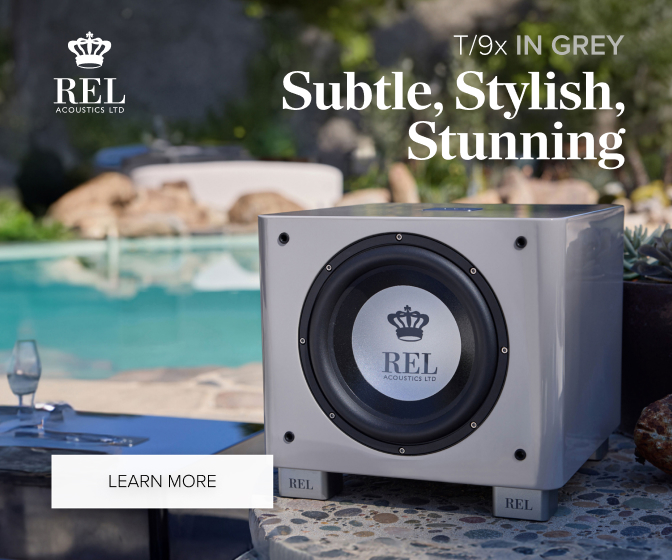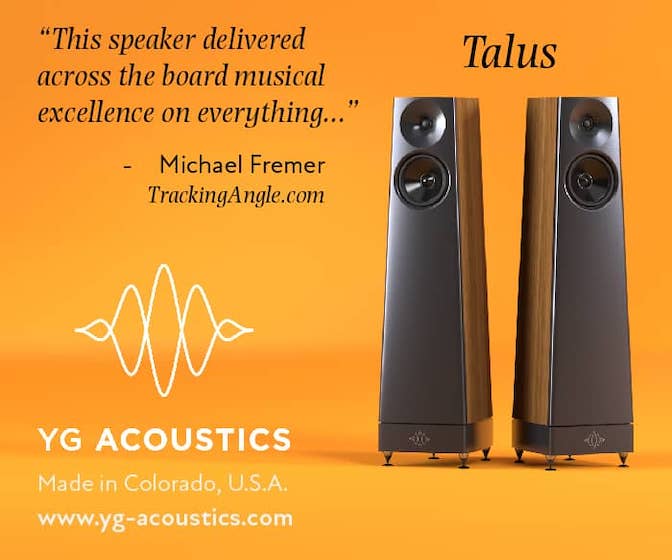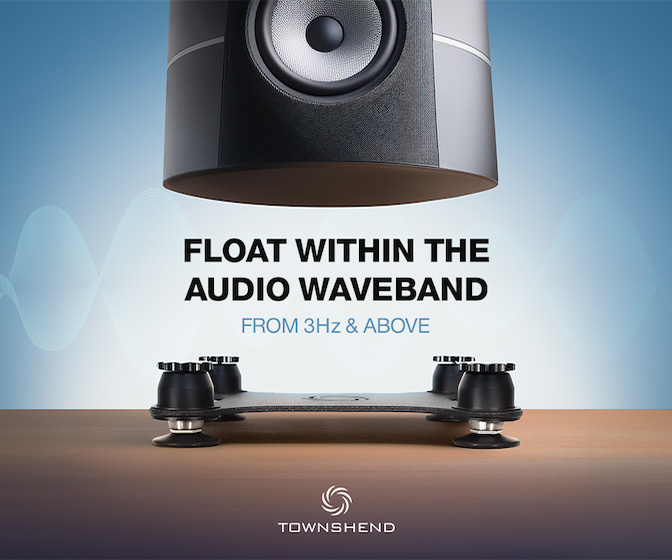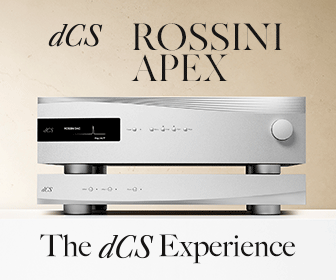YG Talus Loudspeaker—High Performance Built to an Attractive Pricepoint
YG goes downmarket with an upmarket performing loudspeaker
At a press conference during last spring’s Munich High End 2024 YG Acoustics introduced its new “flagship” $498,000 XV 3 Signature loudspeaker—a four tower, limited-to-eight-pairs edition.
This isn’t a review of that speaker, so there’s no point in going through all that went into its design and execution overseen by YG CEO and chief designer Matthew Webster.
No doubt designing and executing this modestly priced Talus loudspeaker introduced in 2023 was at least, if not more difficult than creating the flagship. Why? Because it’s always more difficult to cut corners and design to the price-point than it is to go all out and throw everything you know (and hope to know) into a cost-no-object design.
Some companies that build upper echelon products in any field flop miserably when they attempt to go “down market”. Just as many fail trying to go in the other direction.
YG Peaks Series
Talus is defined as "a sloping mass of rock fragments at the foot of a cliff", which makes sense in a "Peaks" designated lineup. That a sloping mass of rock fragments at the foot of a cliff actually gets a name, doesn't make sense to me, but I'm not a geologist, though I've often been accused of having rocks in my head.
The two-way Talus is the smallest of the three floor standing models in the five speaker (plus a powered subwoofer) Peaks line intended to usher in YG performance "without compromise" at a far lower price point compared to the company's more costly lineup. That's always the goal of these exercises so where did YG begin the bloodletting (used the word for dramatic purposes as no real blood spilled—that I know of)?
First, the designers did away with the costly aluminum enclosures YG has always used, and moved to a one inch thick dense, "environmentally friendly resin mixed with very fine, treated wood fibers, produced under very high pressure to increase its density." The material is gracefully "...curved to exact tolerances in custom presses by experienced European workshops." The sealed boxes include cabinet resonance and reflection eliminating "advanced bracing and acoustic absorbers".
A "white paper" delves into how this material was developed and chosen along with details about the "advanced bracing and acoustic absorbers" that makes for fascinating reading but is too much for the purposes of this review though here's a small excerpt: "These absorber/diffuser panels are optimized precisely to the drive unit and cabinet and they are so effective that they reduce the coherent reflections by up to 98% in the target range of frequencies. Aside from their role with reflections, they further break up cabinet air resonances and provide an additional cabinet brace, making the structure even more inert."
In other words, YG is very seriously committed to both lowering costs to make these more affordable and doing the necessary R&D to maximize performance. While the publicly brochures are written with the usual platitudinous hyperbole, the more interesting backgrounders explain why I heard what I heard but I'm getting ahead of the plot!
Despite Talus's relatively compact dimensions (40" x 10.6" x 12.8") it weighs almost 100 pounds and is fully finished on all sides in a choice of Oak, Ebony or Rosewood. Fully finished means if you need to use a speaker in a room divider type situation you get an attractive rear view. You can take a "spin" here. Using your cursor you can move around the speaker up, down, all around and in all three of the available wood finishes.
The Talus features a ForgeCore™ tweeter and 7.25 inch Billetcore™ woofer. About the tweeter, YG says the motor and enclosure are "unique" and that the design dramatically lowers distortion by "introducing computer-optimized, highly sophisticated 3D geometries into the magnet system, using CNC-cutting of the motor parts. In comparison, standard tweeters use stamped or laser-cut motors, which are limited to mostly 2D features". YG claims the process results in greater long-term listening relaxation.
While the former is a magnet system technology, BilletCore™ is a membrane technology referring to the aluminum cone CNC machining of solid "air-craft grade" billet (there are many "air-craft" grades of aluminum and IMO the term is overused in the audio industry).
YG isn't afraid to "name names" when comparing tweeter distortion of its ForgeCore unit compared to a Scan-Speak Illuminator it previously used in its Sonja 1.1 speaker.
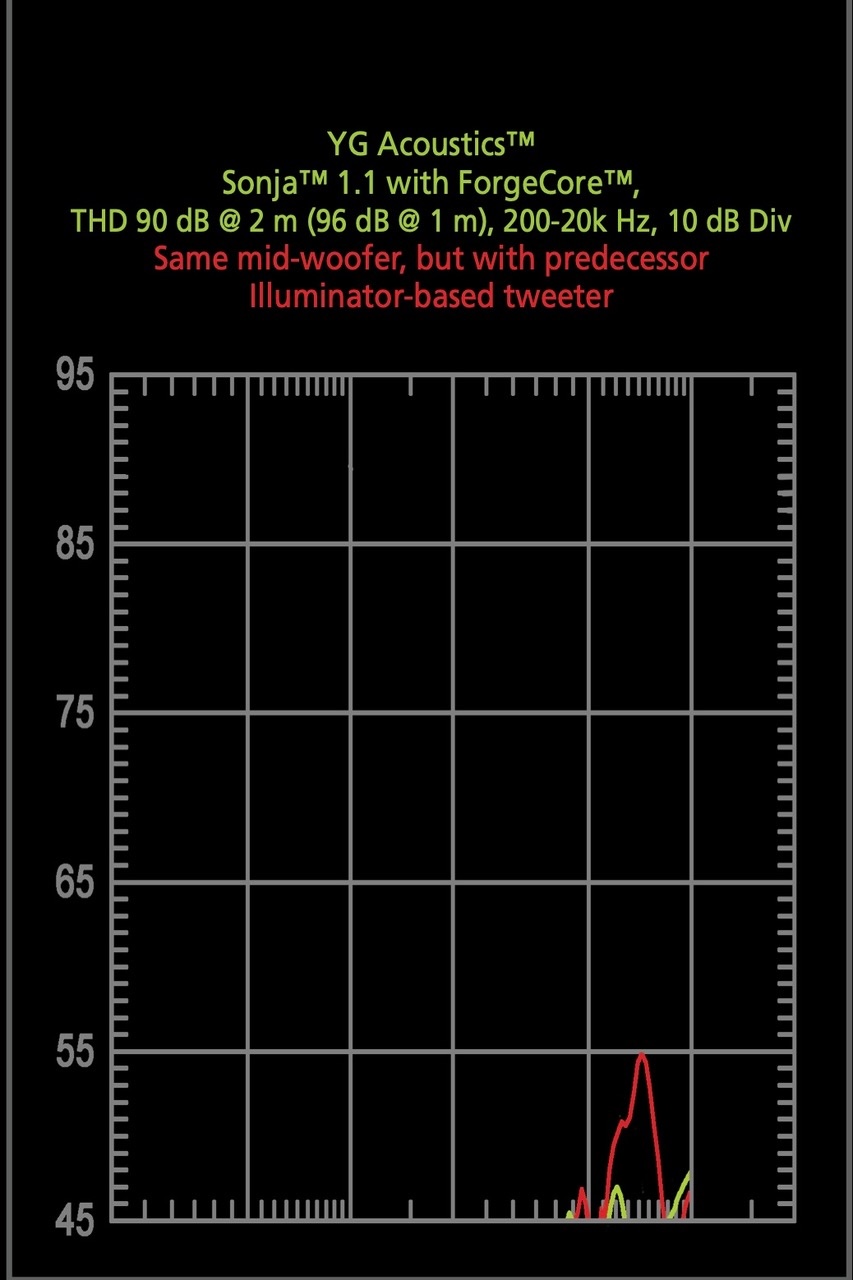
How this translates in the listening experience I cannot say but we all prefer lower distortion don't we? Well actually no. Some people like it in tube amps when it's benign second order multiples of fundamental frequencies that add richness and "fullness". A very little of that properly accomplished goes a very long way with me but your experience may differ.
The drivers mount to a thick, gracefully machined aluminum front baffle with no screws exposed, giving it a pleasing thought somewhat austere look. YG does not offer grills so drivers are exposed to poking fingers so keep that in mind. It should be easy enough to fashion a cap of some sort to place over the top of the cabinet when you're not listening.
Crossover information is somewhat vague in terms of parts used and tolerances. The brochure state "Innovative crossover topologies are optimized through complex simulation and countless hours of critical listening. These designs maximize efficiency and ensure the broadest possible compatibility with amplifiers. The Peaks crossovers use the highest quality components and are hand-built on circuit boards that YG machines in-house." That will have to suffice and IMO is sufficient. The speakers sit on custom metal and polymer spikes and the binding posts are WBT NextGen binding posts manufactured per YG's specs.
Note that the speaker's minimal impedance is almost 4 Ohms and maximum is 7 ohms while efficiency is relatively high for a sealed box design at 89dB. This makes good sense: there's nothing more ridiculous than a moderately priced loudspeaker that to drive requires a super-costly amplifier! The Talus costs $14,200 a pair. Not budget priced for sure but also affordable to many serious audio enthusiasts even if that requires borrowing and paying it off over time.
Set Up
I chose a living room home theater space upstairs set-up rather than downstairs in my main listening room for two reasons. The first being that moving my main speakers is a major deal I'm only willing to do when the replacement is another major deal state of the art type loudspeaker and the second one being that I think most though not all buyers of a speaker like this will be putting it where it has to go in a living situation rather than in a dedicated listening space. I've seen too many "this is my system" videos and still shots to think otherwise. The majority of them show speakers placed as furniture and that's fine too.
I've had many speakers in the home theater space. It's a big rectangular room approximately 25 feet long and 15 feet wide and open on one end. The speakers are set up at one end of the room on the long wall approximately 7 feet apart and 11 feet from the listening position. Following YG's set-up advice I began with the speakers toed about half-way in from directly firing at the listening position. I played a bit with that but ended up there because it produced the best timbral and spatial balance.
The electronics consisted of a Marantz Model 10 pre-amp/processor ($7000) driving two channels of a John Curl designed Parasound Halo A51 five channel amplifier ($5749). The Marantz offers two preset options so I was able to leave alone the carefully setup 5 channel home theater set-up and use the second preset in a wide-open stereo mode with no processing applied. Source was a Sony UltraHD 4K Blu-ray player cable of DSD playback and my trusty USB stick filled with both high resolution vinyl transfers and Bob Ludwig's mastered file of Rufus Reid Presents Caelan Cardello (Liam ARF-1) the record I released and believe me I know so well!
When I'd finished evaluating the speakers I realized how easy it would be to add the home theater subwoofer so I went into the Marantz set-up and did that too.
Sound
Among audiophiles at least, next to selecting a life partner, nothing is more personal than choosing a loudspeaker. Sometimes when I see what people end up with (in both cases) I wonder what they're thinking—not that either is any of my business!
When it comes to loudspeakers the less I hear from one the more I like it. Sometimes I think the same thing after thirty plus years of marriage (but only up to a point after which I get lonely). Chances are good I won't end up liking a speaker if after a short listen I can describe its sonic personality, especially if its low frequency response is intended to produced "warmth" even if there's none in the recording. There are many such "music producing" speakers out there, easy to hear at any audio show. Same with speakers that confuse "bright" with detail.
The best of what's available out there now, in my opinion, are speakers that are not like that but rather that lack personality altogether. Producing a speaker that reproduces bass instead of producing it, is usually costly, especially if it has good low end extension. Manufacturing an enclosure that doesn't "sing"' down there is usually costly. With its resin YG has found a less costly way to achieve similar results.
Talus is a low coloration, honest sounding two-way speaker that can extend down to 32Hz and though I didn't measure the response I'd say in my situation the bottom end was extremely clean, "fast" and well-detailed but probably went down to the 40Hz area, which is lower than you might think. Above the bottom end the upper/bass lower midrange was completely free of lumps and bumps, while the midrange was remarkably open, transparent and detail resolving as I'll get into shortly. The top was fully extended, clean and wide open and with great transient precision.
The result is a speaker devoid of personality, though because it's a two-way and can't really go all the way down with full authority it could (incorrectly) be heard as being "bright". It's not as I confirmed when I later added the subwoofer. But first just the two speakers. This is a speaker you can stare down and not hear.
Remove the lumps, bumps, colors and fanciful sonic incantations the Talus to a great degree avoids and you are left with ear popping resolution that reveals details hiding in plain aural site, and more importantly instrumental verisimilitude, especially in terms of transient clarity and detail. The more complex the material the more your ears will open to almost overwhelming detail resolution.
I'll give you an example. I played the "Third Uncle" from Eno's masterpiece Taking Tiger Mountain (By Strategy) (ENOCD2/724357728829) part of a 2004 CD series mastered DSD at Super Audio Mastering in the U.K. with tape playback on an AMPEX ATR with ARIA electronics by David Hill restored by the late Mike Spitz. The arrival of this deck was sufficiently important to be noticed by Mix Magazine. Listen to this CD and you'll know for certain that the master tapes of this and the other Eno records in the series were in excellent condition. Whatever Miles Showell was given to cut lacquers at 1/2 speed for the last Eno vinyl releases was (he told me) "best available" but it was at best second generation and probably third and not in particularly good condition. Whatever happened to the DSD files used for this CD? I reached out to Super Audio Mastering but haven't heard back.
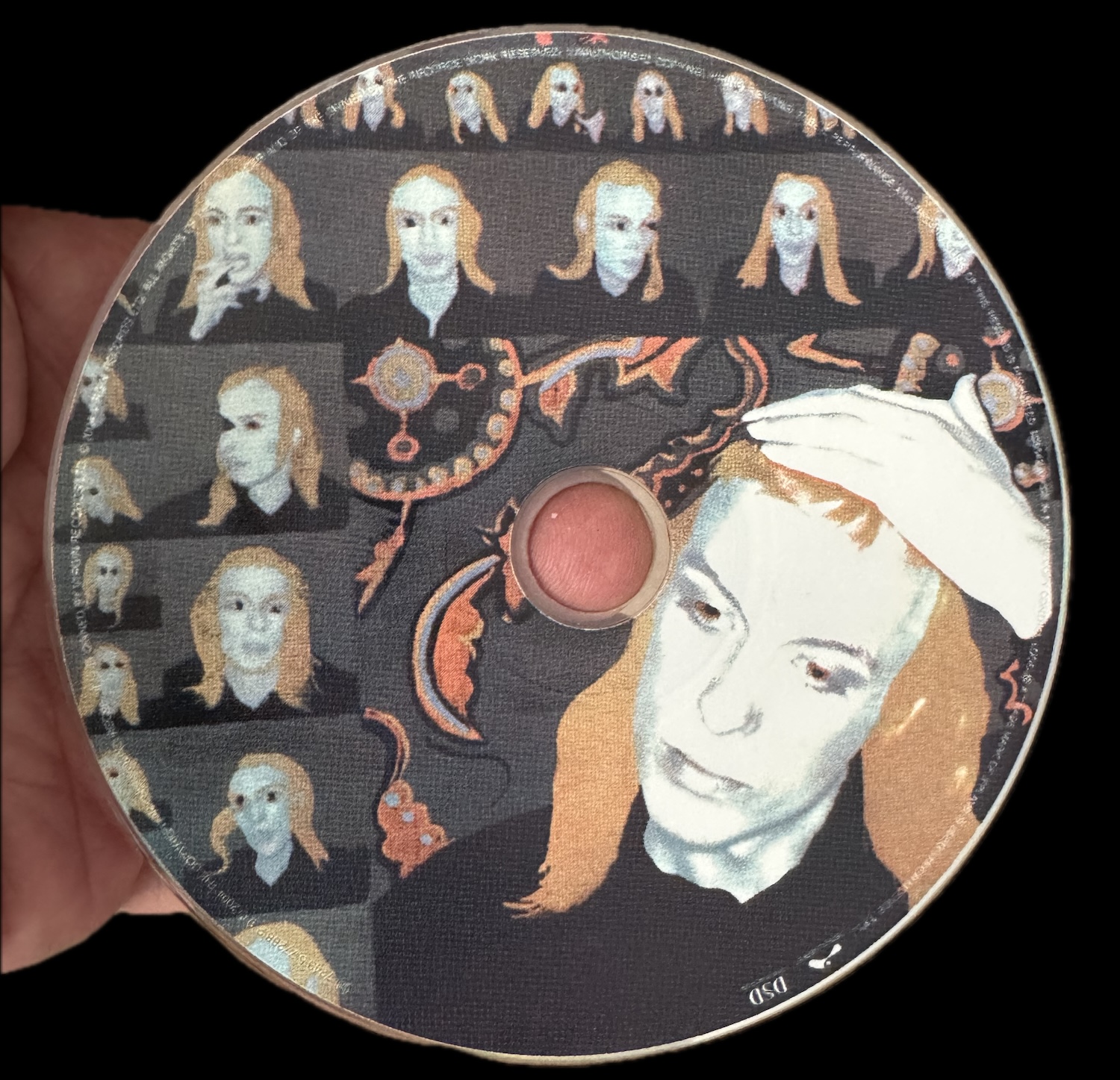
This speaker's reproduction of the snare drum and percussion on "Back in Judy's Jungle" was an ear opener. The kick drum wasn't fully developed on bottom on the chorus ("there were milkmen in the morning" etc.) but its clarity and punch made up for it and it did go deeper than I thought the speaker was capable of going. And it effortlessly revealed in three-dimensions all of the track's inner elements and clarified some in surprising ways. If you know this track, you ought to hear it back through these speakers. You needn't play it back at high SPLs to appreciate it.
The Talus delivered a master class in clarity, detail resolution, black backgrounds, transient precision and image three-dimensionality (albeit on a compact scale compared to what I'm used to through my big system) but I'm not sure which better delivered these details. It took me by surprise. However, I could see how some might find what I heard "punchy, though bright".
Next up was a Joe Harley produced Blue Note XRCD of Hank Mobley's Soul Station manufactured for Elusive Disc back in 2009 (Audio Wave AWMXR-0001). Oh! So this is not a bright loudspeaker. In fact, it's warm, mellow and rich-sounding! Of course the speaker is neither "bright" nor "warm, mellow and rich sounding". Rather, it delivers the sound the source material feeds it.
This reminds of an episode at a hi-fi show some years ago. I was spending time in a particularly good-sounding room that was using a pair of large, boxy aluminum speakers. Disc after disc sounded different, as it should be and really fine and enjoyable since they were well-curated.
A guy walks in asking to hear an opera recording that he said was his 'reference'. The room host put it on and it was excruciatingly bright! After a few minutes the guy says "take it off, honestly that's awful!" Of course the speakers weren't "awful", the recording was! Only a speaker seriously closed in on top and bloated in the midrange could make that recording sound 'good'. I guessed what his reference speaker was, but I won't repeat it here.
I played some vinyl sourced files starting with Kenny Burrell's "Chittlins Con Carne" from the Music Matters Midnight Blue release. Burrell's guitar appeared just to the right of the left speaker in 3D glory, Ray Barrett's congas are in the room on the opposite side with Billy Gene Engllsh's cymbals singly spectacularly cleanly and correctly rendered and then just as that settles in, in comes Stanley Turrentine's sax. That track could sell these speakers to anyone who digs that record, though some might want a bit more weight on Major Holley's bass.
That's When I Figured I Should Try Adding the Subwoofer
Adding the subwoofer was remarkably easy precisely because the speaker designers did not want it to "make music" by adding a warm coloration to simulate bass. The integration was seamless and since the sub wasn't from YG I won't divulge the brand.
The first thing I played was a vinyl transfer of lacquer of "Night in Tunisia" from the Music Matters version of the Blue Note album of the same name. As my late friend Art Dudley used to exclaim, "Holy crap!". The bass line on this track often sounds bloated but not here and that really surprised because adding a sub, as I wrote can be tricky, but beyond that, Bobby Timmons' piano sound was well-controlled and more piano-like than usual. All of the instruments had a "rightness" you'd immediately notice, especially if you'd been playing this track on systems around the world.
Next up was an excerpt of "Pictures at an Exhibition" from a 78rpm stereo microgroove edition Classic Records messed around with as an experiment but never formally released. I brought it to the Florida International Audio Expo a few years ago someone stole it, but oh well, I have the file. The bottom end "womps" and cymbal smacks were everything you'd want, forget about price. Oh of course there's more to be had in terms of dynamics, scale and size and no doubt YG will agree, which is why they make bigger more costly and more advanced speakers, but this was special.
I finished the USB stick performance with "Whole Lotta Love" from the RL transfer and the track demonstrated the speaker's macrodynamic abilities. I played it at healthy SPLs—not crazy—and there was no strain whatsoever. After so many great sounding tracks, especially on the very top where cymbals rang so true, I think the distortion graph near the top of the page is as easily heard and seen.
Conclusion
I tell readers and anyone who will listen that it's important for reviewers accustomed to auditioning only the top stuff to come down as many rungs as they dare to hear what's available for much less. My time with the YG Talus made that point to me and I hope to anyone reading this. Every track I played over the time I've had these speakers in my system (and I also used them for home theater movie viewing and they were equally excellent there), demonstrated that there were sonic surprises in every one of them... produced by what? Maybe the tweeter, maybe the woofer, maybe the crossover, no matter! This speaker delivered across the board musical excellence on everything—even without the subwoofer but the point is, you could buy these and enjoy for however long and then fit a sub into the system with relative ease and not have to fiddle with level or crossover because the Talus is delivering top to bottom musical honesty that will bring pleasure every play. Just be prepared for bad recordings to sound really bad, but great ones? Wow.
Specifications
SPEAKER TYPE
2-way passive floor-standing speaker
DRIVERS
ForgeCore tweeter
18.5 cm (7.25”) BilletCore driver
CROSSOVER
Innovative topology based on detailed computational modeling and extensive listening tests
SENSITIVITY
89 dB
IMPEDANCE
7 Ohms average 3.7 Ohms minimum
DIMENSIONS
101.5 x 27 x 32.5 cm (H x W x D) 40 x 10.6 x 12.8” (H x W x D)
Exceptional phase alignment: ±5° across an octave around each crossover point
Optimized for phase alignment, phase slope and transient response
Exotic components selected to optimize sound quality, such a copper-manganin foil resistors, pure aluminum foil capacitors and OFC ribbon inductors
Computationally optimized layouts to minimize component interactions
RESPONSE
Usable output extends from 32 Hz to 40 kHz
YG ACOUSTICS
WEIGHT
43 kg per speaker 95 lbs per speaker
FINISHES
Ebony, Rosewood, Oak


